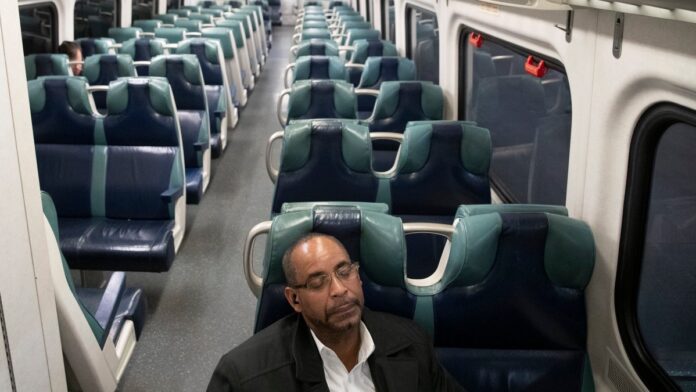Final yr’s COVID-19 outbreak resulted within the proportion of individuals working from dwelling in america virtually doubling, with the shift being most pronounced amongst graduates and employees in areas corresponding to finance {and professional} providers was.
The proportion of employed individuals who work at home has elevated from simply 22% in 2019 to 42% in 2020, the Ministry of Labor mentioned on Thursday.
This was one of many notable findings of an annual authorities survey that paperwork the far-reaching impression of the virus pandemic on the on a regular basis lifetime of Individuals because it broke out in March final yr. The American Time Use Survey exhibits how individuals spent their time in 2020, from work to rest to sleeping. Respondents, who’re all 15 years of age or older, are requested by phone about all of their actions inside a interval of 24 hours previous to the interview. (For 2020, the report solely coated Might by way of December after the virus brought about knowledge assortment to be suspended earlier this yr.)
Because of the pandemic and the widespread social distancing it required, individuals on common spent extra time sleeping, watching TV, gaming, utilizing a pc, stress-free and pondering – and fewer time personalizing and speaking – than prior to now yr Yr 2019. Adults additionally spent extra hours taking care of youngsters of their family on common.
The ballot additionally helps issues that the pandemic has worsened isolation for tens of millions of Individuals. As individuals labored from dwelling or went to highschool on-line, the period of time they spent alone elevated. Amongst Individuals 15 and older, the time they spent alone every day elevated by a median of an hour. For 15 to 19 yr olds it elevated by 1.7 hours per day.
Amongst workers with no less than a Bachelor’s diploma from the age of 25, 65% of these in employment said that they labored from dwelling within the 24-hour survey interval in 2020 – a rise of 28 share factors in comparison with 2019. In distinction, solely 19% of these in employment did in the identical age group, whose most instructional attainment is a highschool diploma, labored at dwelling in 2020, up from 13% in 2019.
The transition to teleworking has been much less widespread in sectors of the economic system that require face-to-face contact or specialised industrial tools – from leisure and hospitality to transportation and utilities – than sectors that don’t.
Whereas the proportion of teleworkers elevated for each women and men, the rise was barely greater for ladies in employment. The proportion of ladies working from dwelling elevated by 23 share factors in 2020 in contrast with a rise of 16 share factors for males.
Extra time at dwelling, at work, or in any other case meant that Individuals spent much less time on the streets. The typical time spent touring, corresponding to commuting to work, decreased by 26 minutes per day from 2019 to 2020.
Liana C. Sayer, director of the Maryland Time Use Laboratory on the College of Maryland, mentioned the transfer to teleworking has doubtless accelerated Individuals’ choice for flexibility in how their work schedules are organized – and will have sparked expectations that employers will accommodate them .
“Staff have indicated in surveys from firms and different analysis teams that they like to work at home and set their begin and finish instances as they discover greatest for his or her different wants,” Sayer mentioned. “Some are signaling that they actually do not wish to return to the best way they have been within the workplace earlier than the pandemic.”
The Division of Labor’s annual survey seeks to measure how, the place, and with whom Individuals spend their time. The newest outcomes present that the elevated quantity of childcare in 2020 is because of the cancellation of classroom classes, sports activities and different occasions for kids. Adults whose youngest little one was between 6 and 12 years previous spent 1.6 hours extra per day caring for a kid whereas doing a unique fundamental job than in 2019.
On the similar time, fewer adults with youngsters supplied childcare on a given day in 2020. This may very well be as a result of much less time was spent choosing up and dropping off youngsters from private actions.
The info additionally confirmed elevated gender-specific variations in childcare: in 2020, in comparison with 2019, girls spent 13 minutes extra per day taking care of youngsters straight of their family, whereas males spent about the identical period of time in 2020 as in 2019.
And ladies spent 46 minutes greater than males doing instructional actions for kids of their family in 2020. In 2019, women and men spent roughly the identical period of time doing it.
Evaluation of survey knowledge from the Brookings Establishment discovered that moms of youngsters below the age of 12 spent a median of greater than eight hours at dwelling taking care of youngsters. The Brookings evaluation additionally discovered that working moms spent 7.4 hours of childcare on weekdays in 2020, and spent extra time doing it, than working fathers, unemployed fathers, and inactive fathers.
“Childcare is now a full-time job for moms,” mentioned Lauren Bauer, Brookings economics scholar. “They spend greater than eight hours a day taking care of youngsters and their working hours have suffered because of this. Even when they mix each childcare and work, they now work lower than they used to. “
With many shops closing resulting from public well being suggestions, the survey discovered that much less time is spent in bars, eating places, grocery shops and malls and extra time is spent at dwelling. Folks aged 15 and over additionally spent extra time with members of their very own family than in 2019 and fewer hours with everybody else.
Folks spent a median of 32 minutes extra per day on train and leisure in 2020 – partially a perform of the decline in employment and journey throughout the pandemic. In addition they watched extra TV and benefited from a couple of extra minutes of sleep every day.
“When individuals are rested, I do not assume it is the worst factor on this planet,” says Daniel Hamermesh, an economist at Barnard School who research the economics of time use. “I’m in favor of extra free time. So I do not assume this suggests something destructive in regards to the economic system that we did not already know. “
___
AP economics author Christopher Rugaber in Washington contributed to this report.














